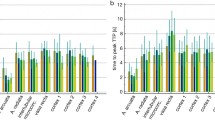Summary
All currently used contrast media in coronary angiography induce a considerable hyperemic response interfering with the interpretation of circulation times derived from myocardial time-density curves. Aim of this study therefore, was to find a contrast agent with minimal hyperemic response. For this purpose 2, 4 and 6 ml of the nonionic isotonic low iodinated contrast agent iohexol (Omnipaque 140®) and 6 ml of a similarly low iodinated but still hypertonic solution of the ionic diatrizoate (Urographin 30%®) were administered into the left coronary artery of 8 anesthetized instrumented dogs. Heart rate was held constant by atrial pacing and left ventricular pressure, left ventricular dP/dt and mean and phasic coronary blood flow were recorded. To test the hypothesis that the hyperemic response to nonionic contrast media is partly due to an increase in inotropic state mediated by CA++ion influx, all measurements were repeated 30 minutes after intracoronary administration of 0.5 mg verapamil. For iohexol the increase in coronary blood flow was small but significant: 12±7%, 25±11% and 38±16% for the 2, 4 and 6 ml administrations, respectively (mean±s.d; p<0.01). For the diluted diatrizoate the increase in coronary blood flow was 65±23%. Increases for currently used contrast agents are on the order of 200–300%. After verapamil, the hyperemic response to iohexol decreased significantly to 9±5%, 20±8% and 29±12% for the 2, 4 and 6 ml administrations, respectively (p<0.01). The reaction to diatrizoate was not affected by verapamil. Moreover, there was a significant positive correlation between the increase in coronary blood flow and left ventricular dP/dt max under all conditions for all but one dog.
We conclude that the isotonic, low iodinated nonionic contrast agent iohexol has only a moderate influence on coronary blood flow, which can be further attenuated by verapamil. By this approach, a more reliable assessment of circulation times from myocardial time-density curves obtained by digital subtraction angiography and videodensitometry becomes possible.
Similar content being viewed by others
References
Ziedses des Plantes BG. Eine Röntgengraphische Methode zur separaten Abbildung bestimmter Teile des Objekts. Fortschr Röntgenstr 1935; 52: 69–79.
Van der Werf T, Heethaar RM, Stegehuis H, Meijler FL. The concept of apparent cardiac arrest as a prerequisite for coronary digital subtraction angiography. J Am Coll Cardiol 1984; 4: 239–244.
Zierler KL. Circulation times and the theory of indicatordilution methods for determining blood flow and volume. In: Handbook of physiology, Section 2: Circulation, Volume 1. Washington DC: American Physiological Society, 1962: 585–615.
Gerber KH, Higgins CB. Comparative effects of ionic and nonionic contrast materials on coronary and peripheral blood flow. Invest Radiol 1982; 17: 292–298.
Schräder R, Baller D, Hoeft A, Korb H, Wolpers HG, Hellige G. Reduced side effects of low osmolality nonionic contrast media in coronary arteriography. In: Tänzer V, Zeitler E, eds. Contrast media in urography, angiography and computerized tomography. Stuttgart, New York: George Thieme Verlag, 1983; 67–77.
Simon R, Koch M, Hermann G, Amende I, Lichtlen PR. Direct effects of an ionic and nonionic contrast agent on the coronary circulation in man. Proceedings Xth World Congress Cardiology, Washington 1986; 294 (Abstract).
Wilson RF, Laughlin DE, Ackell PH, Chilian WM, Holida MD, Hartley CJ, Armstrong ML, Marcus ML, White CW. Transluminal subselective measurement of coronary artery blood flow velocity and vasodilator reserve in man. Circulation 1985; 72: 82–92.
Hodgson JMcB, Mancini GBJ, Legrand V, Vogel RA. Characterization of changes in coronary blood flow during the first six seconds after intracoronary contrast injection. Invest Radiol 1985; 20: 246–252.
Friedman HZ, DeBoe SF, McGillem MJ, Mancini GBJ. The immediate effects of iohexol on coronary blood flow and myocardial function in vivo. Circulation 1986; 74: 1416–1423.
Vogel R, LeFree M, Bates E, O'Neill W, Foster R, Kirlin P, Smith D, Pitt B. Application of digital techniques to selective coronary arteriography: Use of myocardial contrast appearance time to measure coronary flow reserve. Am Heart J 1984; 107: 153–164.
O'Neill WW, Walton JA, Bates ER, Colfer HT, Aueron FM, LeFree MT, Pitt B, Vogel RA. Criteria for successful coronary angioplasty as assessed by alterations in coronary vasodilatory reserve. J Am Coll Cardiol 1984; 3: 1382–1390.
Nissen SE, Elion JL, Booth DC, Evans J, DeMaria AN. Value and limitations of computer analysis of digital subtraction angiography in the assessment of coronary flow reserve. Circulation 1986; 73: 562–571.
Hodgson JMcB, LeGrand V, Bates ER, Mancini GBJ, Aueron FM, O'Neill WW, Simon SS, Beauman GJ, LeFree MT, Vogel RA. Validation in dogs of a rapid digital angiographic technique to measure relative coronary blood flow during routine cardiac catheterization. Am J Cardiol 1985; 55: 188–193.
Vogel RA. Functional imaging of the coronary circulation using digital radiography. In: Yearbook medical publishers 1986; 175–188.
Gerber KH, Higgins CB, Yuh Y-S, Koziol JA. Regional myocardial hemodynamic and metabolic effects of ionic and nonionic contrast media in normal and ischemic states. Circulation 1982; 65: 1307–1314.
Higgins CB, Schmidt W. Alterations in calcium levels of coronary sinus blood during coronary arteriography in the dog. Circulation 1978; 58: 512–519.
Walsh RA, Badke FR, O'Rourke RA. Differential effects of systemic and intracoronary calcium channel blocking agents on global and regional left ventricular function in conscious dogs. Am Heart J 1981; 102: 341–350.
Hoffman JIE. Maximal coronary flow and the concept of coronary vascular reserve. Circulation 1984; 70: 153–159.
Author information
Authors and Affiliations
Rights and permissions
About this article
Cite this article
Pijls, N.H.J., Bos, H.S., Uijen, G.J.H. et al. Is nonionic isotonic iohexol the contrast agent of choice for quantitative myocardial videodensitometry?. Int J Cardiac Imag 3, 117–126 (1988). https://doi.org/10.1007/BF01814884
Accepted:
Issue Date:
DOI: https://doi.org/10.1007/BF01814884




